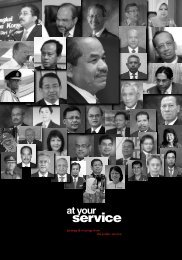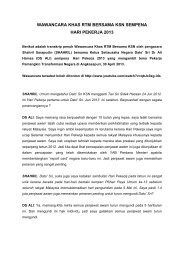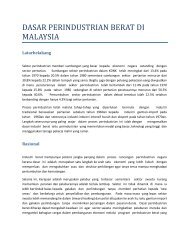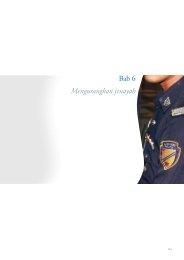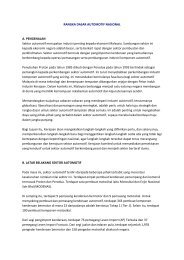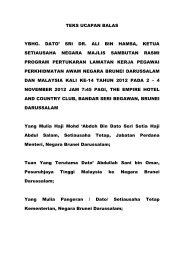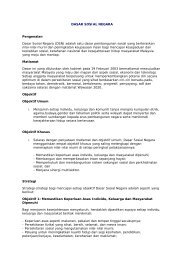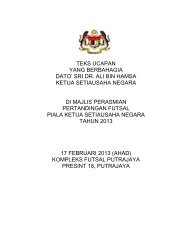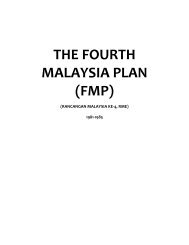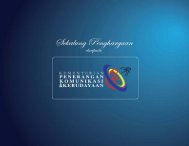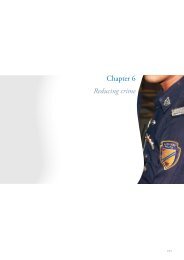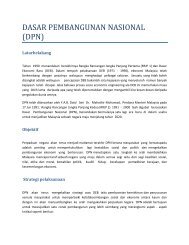GTP 2.0 - Prime Minister's Office of Malaysia
GTP 2.0 - Prime Minister's Office of Malaysia
GTP 2.0 - Prime Minister's Office of Malaysia
Create successful ePaper yourself
Turn your PDF publications into a flip-book with our unique Google optimized e-Paper software.
lOOKING<br />
FORwaRd TO<br />
<strong>GTP</strong> <strong>2.0</strong><br />
7.2<br />
A second focus for LIH NKRA under <strong>GTP</strong> <strong>2.0</strong> is<br />
the development <strong>of</strong> economic enablers – in<br />
other words, creating the right environment<br />
enablers - such things as education, nutrition<br />
and skills training which when properly fostered<br />
in the right environment enable economic<br />
empowerment particularly for vulnerable<br />
groups. The next three years will also take a<br />
more targeted approach in addressing the needs<br />
<strong>of</strong> specific communities such as the Orang Asli<br />
(indigenous people) and Penan communities.<br />
The key measure <strong>of</strong> success for LIH NKRA in<br />
<strong>GTP</strong> <strong>2.0</strong> is to reduce poverty to 2% by 2015 from<br />
3.8%, which means moving 132,000 households<br />
out <strong>of</strong> poverty categories (to ‘terkeluar’ status).<br />
Specific targets include:<br />
Adding another 20,000 participants to<br />
the 1AZAM programme, bringing the total<br />
to 47,000.<br />
Implementing some 85,000 enabling<br />
projects including education, nutrition and<br />
skills training.<br />
With a solid foundation established in <strong>GTP</strong> 1.0, the<br />
role <strong>of</strong> the LIH NKRA takes a significant step forward<br />
in <strong>GTP</strong> <strong>2.0</strong> by introducing a large number <strong>of</strong> specific<br />
initiatives that will target specific areas <strong>of</strong> focus.<br />
<strong>GTP</strong> <strong>2.0</strong> emphasises economic empowerment <strong>of</strong><br />
individuals and communities through productive<br />
welfare, and this effort will require the establishment<br />
<strong>of</strong> basic facilities and the right environment.<br />
THE KEY PRINCIPLES OF LIH <strong>GTP</strong> <strong>2.0</strong><br />
ECONOMIC<br />
EMPOWERMENT<br />
ECONOMIC<br />
ENABLERS<br />
CORE FOCUS<br />
Focus <strong>of</strong> <strong>GTP</strong> <strong>2.0</strong> LIH Lab<br />
AZAM Programme<br />
Fine-tuning the programme:<br />
reaching out to specific<br />
communities<br />
Programmes by NGOs /<br />
COSs / Corporations<br />
Assisting NGOs /CSOs /<br />
Corporations scale-up their<br />
existing out-reach<br />
programmes<br />
SUPPORTING—average on existing Mini?? /<br />
NKRAs if required<br />
Providing the right<br />
environment to enable<br />
economic empowerment<br />
• Health & Nutrition<br />
• Food Aid / Food Bank<br />
• Education for parents and<br />
children<br />
• Skill training programme<br />
• Financial<br />
• Housing Facilities /<br />
maintenance<br />
• Public Transport access<br />
• Child care / elderly care<br />
• Specific needs for<br />
communities e.g. Orang Asli<br />
/ Indigenous communities<br />
/Penan<br />
19%<br />
eKasih<br />
Participants<br />
185,722<br />
81%<br />
Number <strong>of</strong> poor / extreme poor in eKasih<br />
5000<br />
4500<br />
4000<br />
3500<br />
3000<br />
2500<br />
2000<br />
1500<br />
1000<br />
500<br />
0<br />
<strong>GTP</strong> <strong>2.0</strong> will focus on the following four main areas <strong>of</strong> work,<br />
which build on the work <strong>of</strong> <strong>GTP</strong> 1.0:<br />
PRIORITISE eKASIH PARTICIPANTS WHOM<br />
ARE ALREADY REGISTERED<br />
AZAM<br />
Participants<br />
34,858<br />
48%<br />
Non-AZAM<br />
Participants<br />
150,864<br />
52%<br />
25%<br />
No aid<br />
received<br />
71,778<br />
Aid<br />
received<br />
79,086<br />
49%<br />
Only 49% <strong>of</strong> 1AZAM participants<br />
are registered in the eKasih database<br />
1<br />
2<br />
3<br />
5<br />
4<br />
6<br />
REGISTERED 2009<br />
28,374<br />
REGISTERED 2010<br />
16,154<br />
REGISTERED 2011<br />
21,565<br />
REGISTERED 2012<br />
5,676<br />
DISTRICTS IDENTIFIED ACROSS THE COUNTRY<br />
eKasih participation vs.<br />
AZAM participation rate<br />
Marudi<br />
Kuala Terengganu<br />
Kuching<br />
Kota Marudu<br />
Pitas<br />
Semporna<br />
Perlis<br />
Pasir Puteh<br />
Pasir Mas<br />
Nabawan<br />
Bachok<br />
Beluran<br />
Tuaran<br />
Besut<br />
Sarato (Kalaka<br />
SOCIAL ONLY<br />
67,448<br />
SOCIAL + ECONOMIC<br />
11,638<br />
0% 10% 20% 30% 40% 50% 60% 70%<br />
AZAM participation rate<br />
(% <strong>of</strong> eKasih participants classified poor / extreme poor)<br />
Keningau<br />
Tawau<br />
Miri<br />
Sabak Bernam<br />
Papar<br />
Hilir Perak<br />
Kota Bharu<br />
Tumpat<br />
Sandakan<br />
Ranau<br />
WP Kuala Lumpur<br />
Tanah Merah<br />
Seberang Perai Utara<br />
Tongod<br />
132 Government transformation Programme—Annual Report 2012 Chapter seven 133<br />
Government transformation Programme—Annual Report 2012 Chapter seven




